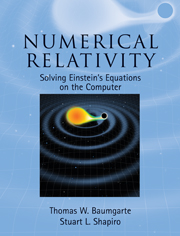Book contents
- Frontmatter
- Contents
- Preface
- Suggestions for using this book
- 1 General relativity preliminaries
- 2 The 3 + 1 decompostion of Einstein's equations
- 3 Constructing initial data
- 4 Choosing coordinates: the lapse and shift
- 5 Matter sources
- 6 Numerical methods
- 7 Locating black hole horizons
- 8 Spherically symmetric spacetimes
- 9 Gravitational waves
- 10 Collapse of collisionless clusters in axisymmetry
- 11 Recasting the evolution equations
- 12 Binary black hole initial data
- 13 Binary black hole evolution
- 14 Rotating stars
- 15 Binary neutron star initial data
- 16 Binary neutron star evolution
- 17 Binary black hole–neutron stars: initial data and evolution
- 18 Epilogue
- A Lie derivatives, Killing vectors, and tensor densities
- B Solving the vector Laplacian
- C The surface element on the apparent horizon
- D Scalar, vector and tensor spherical harmonics
- E Post-Newtonian results
- F Collisionless matter evolution in axisymmetry: basic equations
- G Rotating equilibria: gravitational field equations
- H Moving puncture representions of Schwarzschild: analytical results
- I Binary black hole puncture simulations as test problems
- References
- Index
6 - Numerical methods
Published online by Cambridge University Press: 05 March 2013
- Frontmatter
- Contents
- Preface
- Suggestions for using this book
- 1 General relativity preliminaries
- 2 The 3 + 1 decompostion of Einstein's equations
- 3 Constructing initial data
- 4 Choosing coordinates: the lapse and shift
- 5 Matter sources
- 6 Numerical methods
- 7 Locating black hole horizons
- 8 Spherically symmetric spacetimes
- 9 Gravitational waves
- 10 Collapse of collisionless clusters in axisymmetry
- 11 Recasting the evolution equations
- 12 Binary black hole initial data
- 13 Binary black hole evolution
- 14 Rotating stars
- 15 Binary neutron star initial data
- 16 Binary neutron star evolution
- 17 Binary black hole–neutron stars: initial data and evolution
- 18 Epilogue
- A Lie derivatives, Killing vectors, and tensor densities
- B Solving the vector Laplacian
- C The surface element on the apparent horizon
- D Scalar, vector and tensor spherical harmonics
- E Post-Newtonian results
- F Collisionless matter evolution in axisymmetry: basic equations
- G Rotating equilibria: gravitational field equations
- H Moving puncture representions of Schwarzschild: analytical results
- I Binary black hole puncture simulations as test problems
- References
- Index
Summary
As we have seen, Einstein's field equations in 3 + 1 form consist of a set of nonlinear, multidimensional, coupled partial differential equations in space and time. The equations of motion of the matter fields that may be present are typically of a similar nature. Except for very idealized problems with special symmetries, such equations must be solved by numerical means, often on supercomputers. Just as there is no unique analytic formulation of the 3 + 1 field equations, there is no unique prescription by which a partial differential equation may be cast into a form suitable for numerical integration. Standard numerical algorithms for treating such equations may be found in many textbooks on numerical methods, as well as in textbooks, monographs and review articles on compuational physics. This branch of applied mathematics is a rich area of ongoing investigation; it progresses with each advance in computer technology. It would take us too far a field to review the subject in any depth here. Instead, we shall present a brief introduction to some of the basic numerical concepts and associated techniques, focusing on those most often employed to solve the partial differential equations that arise in numerical relativity. Although our treatment is rudimentary, we hope that it is sufficient to convey the flavor of the subject, especially to readers unfamiliar with the basic ideas. Throughout our discussion we shall refer the reader to some of the literature where further details and other references can be found.
- Type
- Chapter
- Information
- Numerical RelativitySolving Einstein's Equations on the Computer, pp. 183 - 228Publisher: Cambridge University PressPrint publication year: 2010



